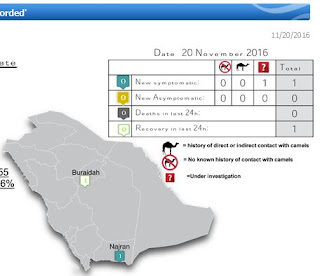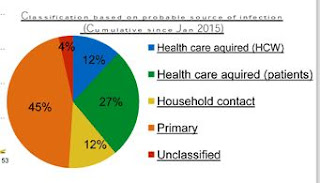#11,925
For the 2nd time this month the Saudi MOH is reporting a primary MERS case from Najran, very near the Yemen border, without a known risk exposure.
Of the 14 cases reported by the Saudis this month, 6 have had reported recent camel exposure, while 8 are `primary' cases with no known exposure to MERS cases or visits to healthcare facilities.
Today's case involves a 59 y.o. female who is listed in critical condition. The MOH also reports the recovery of a 63 y.o. male from Buraidah.
While there are serious concerns over how many MERS cases go unidentified in Saudi Arabia (see EID Journal: Estimation of Severe MERS Cases in the Middle East, 2012–2016), of the 1483 cases reported by the MOH, just over half are attributed to exposure to another MERS case (either in a household, or a healthcare facility).
Of the 49% remaining, fewer than half report camel contact, leaving a big question mark as to how these patients acquired the virus.
We know that MERS-CoV can produce a wide range of illness, and so it is likely that many mild or asymptomatic cases go undetected.
This has led to speculation that limited community transmission via asymptomatic or mild carriers may be occurring. in the EID Journal: Risk Factors For Primary MERS-CoV Infection, Saudi Arabia, researchers found camel exposure to be a significant factor but also noted:
Other potential explanations of MERS-CoV illness in primary case-patients who did not have direct contact with dromedaries include unrecognized community exposure to patients with mild or subclinical MERS-CoV infection or exposure to other sources of primary MERS-CoV infection not ascertained in our study.
Unfortunately we are getting fewer details of late, as the Saudi's CCC weekly monitor - which for almost a year provided us with much appreciated insight on KSA's MERS outbreaks - hasn't been updated in more than 3 months (last edition Volume 2 - Issue 32- Tuesday, August 16, 2016).
While community acquired cases continue to pop up around Saudi Arabia, one bright spot for 2016 has been a marked reduction in the number of nosocomial transmissions of the virus.A sign that the MOH's campaign to improve infection control in healthcare facilities around the Kingdom has made progress, and hopefully a trend they can maintain.


